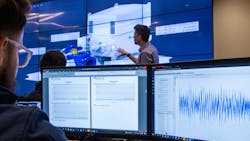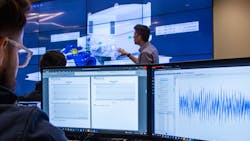In the chemical industry, understanding the health of rotating equipment is crucial for safety and productivity. Regular inspections, compliance with regulations and proactive maintenance are vital for equipment reliability. Ares Panagoulias, the director of condition monitoring and test lab at Hydro Inc., emphasizes the importance of data in assessing equipment health. He advises using remote monitoring to prioritize maintenance and diagnose emerging problems before they become serious and costly events. Chemical Processing sat down with Panagoulias to learn more.
A: I think the biggest thing that's changed is the emergence of software as the driver of a lot of the changes to asset management and maintenance practices. The software that is out there today has really given people control over the assets they have and a lot of insights into the equipment in terms of system performance and equipment degradation. In many cases, the software has advanced faster than the ability of plants to implement these technologies properly and get the full benefit of the information provided.
Another thing that's come up, particularly and acutely in the last few years, is the emergence of non-traditional vendors in this space. The folks who end-users are working with in terms of asset management are not the people they were working with 20 years ago. In fact, it feels like every day, every week, there's some sort of new player coming in with new software, a new way to either take existing data and run algorithms with that data to get better insight into the performance of that equipment or just new products, new sensors, new types of ways of doing things. And I think it's a little bit challenging for end users to understand “Who do I go with? Who's going to give me a return on investment? Who's going to be around, who's in this for the long haul?”
Q: What are some of the other challenges that you're seeing out there?
A: There is a definite challenge in terms of replacing the experience end-users have on site. When it comes to maintenance execution, when it comes to experience with rotating equipment, there's just a lack of that in the industry. How many times have we had conversations about replacing the knowledge that has come before as people go into retirement? And in today's market, employee turnover is very high. So, it becomes difficult even to take the insights you get from asset management and turn them into reliability actions that will extend the life of equipment. So that's one thing — proper maintenance execution. I think the second one is really an understanding of the process conditions that are at play. It's one thing to talk about asset management and trending and understanding those components to it, but if we don't know the process, if we don't know the conditions we're putting this rotating equipment in, it becomes difficult for us to get the most value out of the data that we're collecting.
So those two things, and then I would probably pair that with design and manufacturing. A lot of plants that were designed in the 60s, 70s and 80s are still running today and are running with very different conditions and very different manufacturing goals than they were at those times. And the equipment, in a large part, hasn't changed. So, how do we adapt our asset management and reliability approach for those pieces of equipment in today's manufacturing environment? That's something we've seen a lot of action around, a lot of areas for us to fill in gaps.
Q: What’s next? What technology do you see on the horizon that might change the way we interact with our assets?
A: I think our perspective is really that the types of sensors, the types of data collection tools that we're using — the hardware, has continued to become a commodity. Yes, there are differences in the minutia of how certain sensors work versus others. Yes, there are different ways to collect the same data in different places. However, by and large, I think being a hardware producer and provider is a commodity product that will really come down to low cost once you've met a certain bar of performance. The big difference is going to be in the software, not just in the software's capabilities in terms of analytics and diagnostics but in terms of data visualization, in terms of digital twin representation.
So, taking live dynamic data from a plant and overlaying that into a digital version of that plant, testing different conditions, different simulations, and bringing in simulation software within that space so that we can proactively determine what equipment is going to fail. Not just, "Hey, this bearing's going bad," or, "Hey, this seal's going bad," or, "Hey, we've got a misalignment there." Those are acute examples, but I'm talking about real proactive maintenance plant-wide and fleet-wide. The software that has the power to do that can integrate into ERP systems or CMMS systems. It can actualize data into maintenance action — that's the future. That's where we're going. It is a very difficult roadmap to navigate. It will take significant investment from a lot of the end-users out there, but that's the future, and that's where we're going.
A: What I’ve seen with the end-users I work with today are challenges with data overload. People have invested in technologies to collect data, but it can be overwhelming to connect rotating equipment that you previously took samples on once a month or once a quarter or once a year. Now, suddenly, you’re getting data on these assets once an hour or once every five minutes or continuously. And it's almost like, “I never knew there were this many alarms or this many critical conditions or events that occurred.”
How do we navigate managing all that data? That's the first challenge that I think comes up a lot. We have certain installations that we've done where we get a lot of nuisance alarms and navigating that, setting up proper notification systems for end-users so that when an event occurs, it actually means we need to take action. That is one of the first challenges that we overcome when we connect systems.
The second challenge that I would throw out there is data quality. I mentioned earlier that once we get to a certain level of confidence with the hardware that we're using, the hardware is kind of a commodity. In contrast, I think software and data quality are incredibly important in terms of their ability to affect return on investment. Because if you’re not getting quality data, if you’re getting data that leads to incorrect or incomplete assessments of equipment, then it's not worth the investment you’ve made. One example is when you start seeing upward trends in overall vibrations, or you start to see anomalies in terms of current in an alternating current mode, or whatever the case may be. It's one thing to flag it, but without that real deep analytical data to diagnose what's going on, to actually determine maintenance action steps, we're not connecting all the dots. So, the data quality is critical.
Q: How can people reconcile the data overload and data quality issues?
A: There's no perfect answer to that, and I wouldn't be here purporting that I have the answer. I will say there are some strategies that I think work and help people get to that place. One would be using alarm systems to notify us at different thresholds when things need attention. So we can't pay attention to everything everywhere all at once, but we can, with certain systems, prioritize our attention on the assets that need help. And then I would say the other thing is remote monitoring. Remote monitoring offers us the ability to see remotely what's going on with different assets at different locations in the plant in real-time. Those systems paired with SME support, whether that be internal or external, can really help respond to alarm events with the information needed as fast as possible.
Q: Anything in the field that you've seen that you can offer as an example?
A: One that comes to mind in the chemical industry is vacuum pumps; they're all over the place. Not just a chemical process but in many different types of installations. And a certain chemical end-user is having a very difficult time with a problem vacuum pump that, unfortunately, is tied to the production process. So, if this vacuum pump goes down, it causes issues for that line. And so, with remote monitoring, they are able to start collecting vibration data in real-time as opposed to route-based or sending somebody out there when there is an incident. This allows them to understand why the incidents are happening when they are happening. So, instead of intermittent sampling, now a more consistent real-time sampling allows them to see those issues.
For more information, visit: https://hydroinc.com


